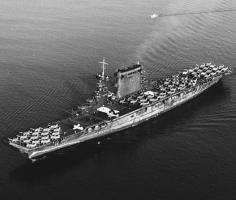 When was the first surprise attack by carrier aircraft on the US naval base at Pearl Harbor, Hawaii? The obvious answer is the Japanese carrier attack of December 7th, 1941. But what about February 7th, 1932?
When was the first surprise attack by carrier aircraft on the US naval base at Pearl Harbor, Hawaii? The obvious answer is the Japanese carrier attack of December 7th, 1941. But what about February 7th, 1932?
We posted yesterday about the recent discovery of the wreck of the USS Lexington. Here is a fascinating bit of forgotten history about the “Lady Lex” and her sister carrier, USS Saratoga.
Early on the Sunday morning of February 7, 1932, the aircraft carriers USS Saratoga and USS Lexington launched a surprise attack on Pearl Harbor. Instead of high explosive bombs, they dropped sacks of flower and scored direct hits on the airfields and all the ships in the harbor.
The surprise attack was part of the Grand Joint Exercise No. 4 and was intended to simulate a Japanese attack on the naval base. The mock-attack was designed to test Pearl’s defenses and assess its vulnerability to an attack.
The attacking force was under the command of Rear Admiral Harry Yarnell, who was one of the few admirals who was also a naval aviator. Aircraft carriers were still a relatively new technology. Both the USS Saratoga and USS Lexington were originally intended to be battlecruisers but were converted to aircraft carriers while on the building ways. They were only the second and third carriers in the Navy and were the first large carriers. Each entered service in 1928. By 1932 aircraft carrier tactics were still being developed.
In previous years, mock naval attacks on Pearl Harbor had featured battleships and cruisers. Radio traffic from the approaching fleet would tip off the defenders at Pearl Harbor and allow the fleet to take to sea for the mock battle. Admiral Yarnell left much of his fleet in San Diego. He held his battleships and cruisers back while his carriers approached under radio silence. When in range Yarnell launched 152 planes from the two carriers. The surprise was complete. The judges ruled that the mock-attack was a complete success.
So, did the Navy pay attention and take meaningful action to ensure that no such attack could ever succeed again? Of course not. They basically replied, “You can’t sink my battleship.”
From Military.com: The brass said that Yarnell had cheated. He had attacked at dawn on a Sunday morning, a time considered “inappropriate” for an attack. His attack vector from the north-northeast had mimicked planes arriving from the mainland. Most importantly, the Navy argued, low-level precision bombing of battleships at anchor was unrealistic since “everyone knew that Asians lacked sufficient hand-eye coordination to engage in that kind of precision bombing.” Pressured by the War Department, the umpires reversed their decision and declared that the defenders had won the exercise. The Navy and its “battleship admirals” ignored Yarnell’s contention that Pearl Harbor was vulnerable to an attack by naval air power. The exercise was widely reported in the press and was observed by Japanese naval officers at the Japanese consulate on Oahu.
In case they missed it the first time, Pearl Harbor was attacked by American carrier planes from the USS Saratoga again in the winter of 1938 during the annual war games. Admiral Ernest King launched the aerial attack to make the point that Pearl Harbor was still vulnerable. No one, with the exception of the Japanese, was paying attention.
The US Navy was still ruled by battleships and battleship admirals. Between 1932 and 1941, the navy ordered twelve more battleships but only four aircraft carriers.
When the Japanese did launch a surprise carrier attack on Pearl Harbor on December 7, 1941, all eight battleships were damaged and four were sunk. The Japanese also sank or damaged three cruisers, three destroyers, an anti-aircraft training ship, and one minelayer. The only good news was that the US Navy carriers, including the USS Lexington and the USS Saratoga, were at sea and were not damaged in the attack.
Strangely, both the USS Lexington and the USS Saratoga were ultimately sunk by the US military. USS Lexington was crippled by Japanese attacks in the Battle of the Coral Sea in 1942. On fire and burning out of control, she was sunk by a US destroyer to prevent her from being captured.
USS Saratoga survived the war only to be sunk in 1946 in tests of atomic blasts at Bikini Atoll.

Hi Rick,
Hope all is well! You need to change the date in the third from last paragraph, or is this a test?
“When the Japanese did launch a surprise carrier attack on Pearl Harbor on December 7, 1945, ”
B
Is this the all time worst US military SNAFU?
‘2nd Pearl Harbor,’ kept
top secret until 1962,
commemorated
https://www.stripes.com/news/2nd-pearl-harbor-kept-top-secret-until-1962-commemorated-1.410773
Why bother to realize something is wrong when it is easier to troll results. We have learned nothing with time..
Great story! Never heard anything about this before, thanks.
I wonder if the obstinate battleship admirals would believe in climate change now!?